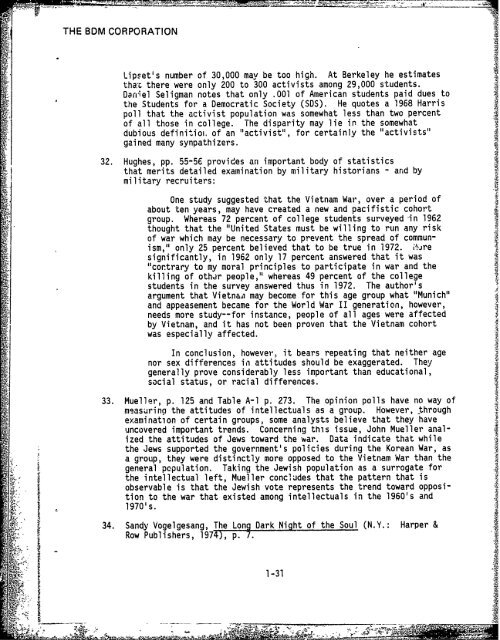policy - The Black Vault
policy - The Black Vault
policy - The Black Vault
You also want an ePaper? Increase the reach of your titles
YUMPU automatically turns print PDFs into web optimized ePapers that Google loves.
THE BDM CORPORATION<br />
Lipset's number of 30,000 may be too high. At Berkeley he estimates<br />
that there were only 200 to 300 activists among 29,000 students.<br />
Daniel Seligman notes that only .001 of American students paid dues to<br />
the Students for a Democratic Society (SDS). He quotes a 1968 Harris<br />
poll that the activist population was somewhat less than two percent<br />
of all those in college. <strong>The</strong> disparity may lie in the somewhat<br />
dubious definitioi. of an "activist", for certainly the "activists"<br />
gained many synpathizers.<br />
32. Hughes, pp. 55-56 provides an important body of statistics<br />
that merits detailed examination by military historians - and by<br />
military recruiters:<br />
One study suggested that the Vietnam War, over a period of<br />
about ten years, may have created a new and pacifistic cohort<br />
group. Whereas 72 percent of college students surveyed in 1962<br />
thought that the "United States must be willing to run any risk<br />
of war which may be necessary to prevent the spread of communism,"<br />
only 25 percent believed that to be true in 1972. i'!Jre<br />
significantly, in 1962 only 17 percent answered that it was<br />
"cortrary to my moral principles to participate in war and the<br />
killing of other people," whereas 49 percent of the college<br />
students in the survey answered thus in 1972. <strong>The</strong> author's<br />
argument that Vietnan may become for this age group what "Munich"<br />
and appeasement became for the World War II generation, however,<br />
needs more study--for instance, people of all ages were affected<br />
by Vietnam, and it has not been proven that the Vietnam cohort<br />
was especially affected.<br />
In conclusion, however, it bears repeating that neither age<br />
nor sex differences in attitudes should be exaggerated. <strong>The</strong>y<br />
generally prove considerably less important than educational,<br />
social status, or racial differences.<br />
33. Mueller, p. 125 and Table A-l p. 273. <strong>The</strong> opinion polls have no way of<br />
measuring the attitudes of intellectuals as a group. However, through<br />
examination of certain groups, some analysts believe that they have<br />
uncovered important trends. Concerning this issue, John Mueller analized<br />
the attitudes of Jews toward the war. Data indicate that while<br />
the Jews supported the government's policies during the Korean War, as<br />
a group, they were distinctly more opposed to the Vietnam War than the<br />
general population. Taking the Jewish population as a surrogate for<br />
g- the intellectual left, Mueller concludes that the pattern that is<br />
, observable is that the Jewish vote represents the trend toward opposition<br />
to the war that existed among intellectuals in the 1960's and<br />
- 1970's.<br />
A<br />
34. Sandy Vogelgesang, <strong>The</strong> Long Dark Night of the Soul (N.Y.: Harper &<br />
Row Publishers, 1974), p. 7.<br />
1-31<br />
U<br />
~___________________________ tw
















